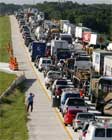| |
|
| |
|
 |
Supply
Chain by the Numbers |
| |
|
| |
- Nov. 11, 2021
|
| |
|
| |
|
| |
|
| |
Inflation and Meatflation Soaring; Maersk Line Acquires US Fulfillment 3PL; Where is the Infrastructure Bill Money Going; Apparel Brands moving Away from China and Asia Sourcing |
| |
|
| |
| |
| |
| |
24% |
|
| That is by how much beef prices at US grocery stores rose in October versus 2020 levels, according to the Consumer Price Index report this week from the Labor Department. Rising cost for steak and more has spawned a new term – “meatflation.” But there is plenty of regular inflation too, according to the report, with the level of price hikes hitting a three-decade high. The overall CPI increased in October by 6.2% from a year ago. That was the fastest 12-month pace since 1990 and the fifth straight month of inflation above 5%. On a monthly basis, the CPI increased a seasonally adjusted 0.9% in October versus the prior month, a sharp acceleration from September’s 0.4% rise and the same as June’s high 0.9% pace. Overall food prices for both groceries and dining out rose by the most in decades.. |
|
|
| |
| |
|
|
|
| That is the percent of its manufacturing that US shoe maker Steve Madden has moved from China to Brazil and Mexico, the company said this week, as continued shiping delays and supply troubles are causing a number of apparel companies to move production back closer to home. Spanish fashion retailer Mango told Reuters last week that it has "accelerated" its process of increasing local production in countries such as Turkey, Morocco and Portugal from China and Vietnam. Meanwhile, shoe make Crocs said last month it was moving production to countries including Indonesia and Bosnia. Bulgaria, Ukraine, Romania, the Czech Republic, Morocco and Turkey were some of the countries drawing new interest from clothing and shoe producers. Closer to the US, retailer Nordstrom significantly shifted its private-label production to Guatemala from Asia in 2020. So apparel sourcing is changing – but still to mostly low cost countries, not the US or fully developed European countries. |
| |
| |
|
|
| |
| |
$550 Billion |
 |
That is the level of actual net increase in “infrastructure” spending over a number of years versus what was already planned, as will soon be called for under the new nominally $1 trillion plan now soon to be signed into law by President Biden. So where’s the money going? Lots of places: Roads, bridges, and major projects: $110 billion; Passenger and freight rail: $66 billion; Public transit: $39 billion; Airports: $25 billion; Port infrastructure: $17 billion; Transportation safety programs: $11 billion; Electric vehicles: $7.5 billion; Modernizing the Electric Grid: $65 billion; Internet Access: $65 billion; Water and Wastewater: $55 billion; among other places. How will it all be paid for? That is the $550 billion question. |
| |
| |
| |
| |
| |
|
|
|
| |
 |
 |
| |
 |
![]() |
 |
|
| |
 |
Feedback |
|
|
|
![]()
|
No Feedback on this article yet.
|
|
![]() |
|
|
|
![]() |
 |
![]() |
 |
|
| |